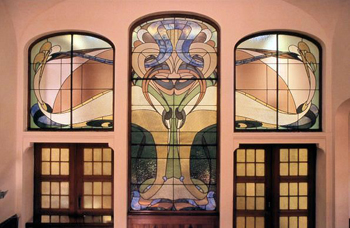Product Description
Henry van de Velde Silver mounted Eugene Baudin French Art Nouveau vase c. 1900


HENRY VAN DE VELDE (1863-1957) Belgium (design mount)
for “LA MAISON MODERNE” Paris, France
ALPHONSE-EDOUARD DEBAIN France (execution mount)
EUGÈNE BAUDIN (1853-1918) France (pottery)
Vase c. 1900
Matte-glazed pottery, cranberry bright turquoise and white highlights, elaborate Art Nouveau whiplash silver mount.
Marks: E Baudin, AD (silversmith monogram), French 950 silver assay mark
For more information on van de Velde ceramics see: Ceramics of the 20th Century, Tamara Préaud and Serge Gauthier (New York: Rizzoli, 1982) illus. no. 67, p.42; Art Nouveau and Art Deco Silver, Annelies Krekel-Aalberse (New York: Harry N. Abrams, Inc.,1989), pp. 63, 90, 264.
For other A-E. Debain designs see: The Paris Salons 1895-1914, Vol. V: Objets d’Art & Metalware, Alastair Duncan (Woodbridge, Suffolk: Antique Collectors’ Club, 1999), p. 208.
For related Van de Velde mount designs see: Jugendstil, Irmela Franzke (Munich: Battenberg Verlag, 1987), illus. 169, p. 87.
H: 8 1/4” x W: 4”
Henry van de Velde Silver mounted Eugene Baudin French Art Nouveau vase c. 1900
GUSTAV GURSCHNER (1873-1970) Austria
Vase c. 1905
Cast bronze ovoid shaped vase with decorative Celtic motif, lightly gilded, the body of the vase simulating leather with a rich brown patina
Signed: GURSCHNER, M180 (stamped in the bronze)
Related works illustrated: The Studio, Special Summer Number 1906: The Art Revival in Austria, ill. no. D6; Studio Yearbook (London, 1909), pp. 139-140; Vienna Turn of the Century: Art and Design, Fischer Fine Art, exhib. cat. (London 1979), p. 23, illus. 1; Bronzes, sculptors & Founders, H. Berman, (Atglen 1994 III) p. 781, cat. nos. 2893, 2894; Decorative Art 1880-1980, Dan Klein & Margaret Bishop (Oxford, England: Phaidon and Christie’s Limited, 1986) p. 84, illus. 1
H: 7 1/4″ x D: 7″ x D: 4″
Price: $14,500
Gustav Gurschner was born in Tirol, Austria. He attended the Fachschule für Holzindustrie in Bozen from 1885-1888. After three years, his instructors encouraged him to attend the Austrian Museum for Applied Arts’ Kunstgewerbeschule in Vienna. After finishing his formal training, Gurschner pursued a career as a sculptor of monumental works. It was while he was in Paris in 1897, that he first turned his energies from the application of small-scale, sculptural works to the aesthetic design of household objects. Shortly thereafter, he returned to Vienna to join the Secessionists whose ideals he shared. By the turn-of-the-century, Gurschner was not only one of the better known artists working in Vienna but enjoyed a reputation that extended into other European countries as well.
